
The brown-tail moth is a moth of the family Erebidae. It is native to Europe, neighboring countries in Asia, and the north coast of Africa. Descriptions of outbreaks, i.e., large population increases of several years duration, have been reported as far back as the 1500s. The life cycle of the moth is atypical, in that it spends approximately nine months as larvae (caterpillars), leaving about one month each for pupae, imagos and eggs. Larvae (caterpillars) are covered in hairs. Two red spots on the back, toward the tail, distinguish these species from other similarly hairy moth larvae. The winged adults have white wings and a hairy white body with a tuft of brown hair at the tip of the abdomen. Females lay one egg cluster, usually on the underside of a leaf of a host plant. The species is polyphagous, meaning that it feeds on many different species of trees, including pear, apple, maple and oak.

The rough prominent is a moth of the family Notodontidae, subfamily Phalerinae. It is also known as the white-dotted prominent and the tawny prominent. The species was first described by James Edward Smith in 1797. This common moth is found across North America from the northern boreal forests to as far south as Florida. It is most common in deciduous forests at some elevation. It is nocturnal but attracted to lights. The moths start to fly soon after dusk and return to resting places some time before dawn breaks. The adults live through late spring and early summer, and larvae are active until fall. They then pupate until the following spring.

Pterophorus pentadactyla, commonly known as the white plume moth, is a moth in the family Pterophoridae. It is found in the West Palearctic including North Africa and Europe. The wingspan is 26–34 mm (1.0–1.3 in). It is uniformly white, with the hind wing pair divided in three feathery plumes and the front pair in another two. The moths fly from June to August. The larvae feed on bindweed.

Ceratomia amyntor, the elm sphinx or four-horned sphinx, is a North American moth in the family Sphingidae. The species was first described by Carl Geyer in 1835. It has a wingspan of 3+1⁄4-4+1⁄2 inches. As the name suggests, the larvae (caterpillars) feed on elm trees (Ulmus), but they can also be found feeding on birch (Betula), basswood (Tilia), and cherry (Prunus). When the caterpillars are ready, they crawl to the bottom of the host tree, where they crawl underneath the soil and pupate and may overwinter underground if late enough into the year. Vegetable growers should be aware of this larvae due to its insatiable appetite. One of these larvae are capable in devouring huge amounts of plant's foliage and even succulent stems.

The Limacodidae or Eucleidae are a family of moths in the superfamily Zygaenoidea or the Cossoidea; the placement is in dispute. They are often called slug moths because their caterpillars bear a distinct resemblance to slugs. They are also called cup moths because of the shape of their cocoons.

Orgyia leucostigma, the white-marked tussock moth, is a moth in the family Erebidae. The species was first described by James Edward Smith in 1797. The caterpillar is very common especially in late summer in eastern North America, extending as far west as Texas, California, and Alberta.

The saddleback caterpillar is the larva of a species of moth native to eastern North America. It is also found in Mexico. The species belongs to the family of slug caterpillars, Limacodidae.
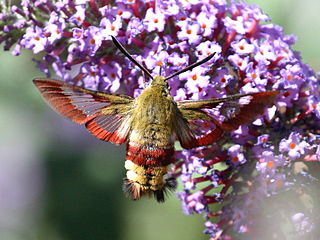
Hemaris fuciformis, known as the broad-bordered bee hawk-moth, is a moth of the family Sphingidae.

Peridea anceps, the great prominent, is a moth of the family Notodontidae first described by Johann August Ephraim Goeze in 1781. It is found in central and southern Europe and North Africa.

Batrachedra praeangusta is a moth of the family Batrachedridae which is native to Europe. It is also found in North America. It was first described by Adrian Haworth in 1828 from the type specimen found in England. The foodplants of the larvae are poplars and willows.

Prays oleae is a moth of the family Plutellidae found in Europe.
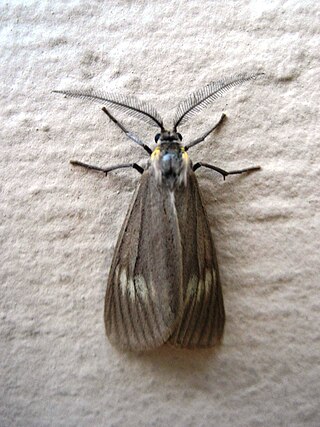
Phryganidia californica, the California oakworm or California oak moth, is a moth of the family Notodontidae. The species was first described by Alpheus Spring Packard in 1864. It is found along the coasts of the US states of California and Oregon.
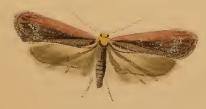
Blunt’s flat-body or purple carrot-seed moth is a moth of the family Depressariidae. It is found in most of Europe. It is also found in the Near East, North Africa, the eastern part of the Palearctic realm and since 2009 in North America.
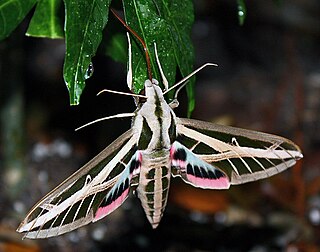
Eumorpha fasciatus, the banded sphinx, is a moth of the family Sphingidae. The species was first described by Johann Heinrich Sulzer in 1776.
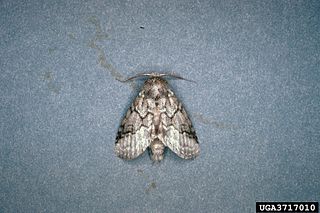
Lochmaeus bilineata, the double-lined prominent moth, is a moth of the family Notodontidae. It is found in the eastern two-thirds of the United States and southern Canada, west to New Mexico in the south and Saskatchewan in the north.
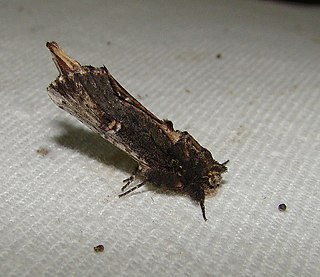
Schizura ipomoeae, the morning-glory prominent moth or false unicorn caterpillar, is a moth of the family Notodontidae. The species was first described by Edward Doubleday in 1841. It is found in the United States and southern Canada.
Clostera inclusa, the angle-lined prominent moth, many-lined prominent or poplar tentmaker, is a moth of the family Notodontidae. The species was first described by Jacob Hübner in 1831. It is found in North America, including Arkansas, Colorado, Florida, Georgia, Illinois, New Hampshire, New York, North Carolina, Oklahoma, Ontario, Oregon, Pennsylvania, South Carolina and Virginia.

Cecrita guttivitta, the saddled prominent moth, is a species of moth of the family Notodontidae. It is found in North America, including Alabama, Arkansas, Connecticut, Delaware, Florida, Georgia, Illinois, Indiana, Iowa, Kansas, Kentucky, Maine, Maryland, Massachusetts, Minnesota, New Brunswick, New Hampshire, New Jersey, New York, North Carolina, Ohio, Oklahoma, Ontario, Pennsylvania, South Carolina, Tennessee, Vermont, Virginia, West Virginia and Wisconsin.

Polyphagozerra coffeae, the red coffee borer or coffee carpenter, is a moth of the family Cossidae. It was described by John Nietner in 1861 and is found in Asia. Records from the Moluccas and New Guinea refer to Polyphagozerra reticulata, which was previously considered to be a synonym of P. coffeae. It is a widespread pest that attacks many plants.

Lymantria dispar dispar, commonly known as the gypsy moth, European gypsy moth, LDD moth, or North American gypsy moth or spongy moth, is a species of moth in the family Erebidae. It has a native range that extends over Europe and parts of Africa, and is an invasive species in North America.




















